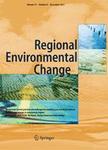版权所有:内蒙古大学图书馆 技术提供:维普资讯• 智图
内蒙古自治区呼和浩特市赛罕区大学西街235号 邮编: 010021

作者机构:BRGM Water Econ Unit F-34000 Montpellier France CSH New Delhi India SupAgro Montpellier France CESS Hyderabad Andhra Pradesh India Irstea Montpellier France
出 版 物:《REGIONAL ENVIRONMENTAL CHANGE》 (地区性环境变化)
年 卷 期:2012年第12卷第3期
页 面:423-436页
核心收录:
学科分类:0830[工学-环境科学与工程(可授工学、理学、农学学位)] 08[工学]
基 金:French Research National Agency (ANR) [ANR-08-VULN-010-01]
主 题:Adaptive capacity Analytic hierarchic process Compromise programming Global change India Multi-criteria analysis Sustainable livelihood approach Catchment basin management
摘 要:Global changes are already having an impact on South Indian farmers. Climate change is affecting the agricultural sector since it is dependent on climatic conditions and water resource availability. The impacts tend to be greater in semi-arid hard rock areas with few water resources. Furthermore, South India area is experiencing a profound agrarian crisis, which is linked, among others, to debt and credit problems. The study reported in this paper aims to develop a methodology to compare and rank farmers according to their ability to adapt to global change. The definition of adaptive capacity is based on a livelihood assets approach. Indicators are evaluated through individual surveys among farmers, then, weighted using the analytic hierarchy process and aggregated via compromise programming. The result is a standardized score measuring the distance of each farmer from an ideal adaptive capacity. Farmers are ranked according to this distance, which allows a comparison of their relative ability to adapt. At the basin scale, it shows that the geographic position of farmers is a significant factor in adaptation performance. The proximity of an administrative center contributes to an increase of their adaptive capacity. Small farming areas limit the adaptive capacities of marginal and small farmers while the largest farmers are constrained by economic factors such as large loans. These study findings offer interesting indications on the variability of farmers weaknesses and are bringing a better understanding of the causes of poor performance.